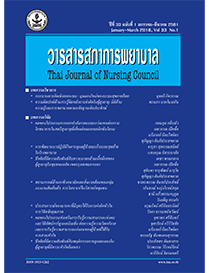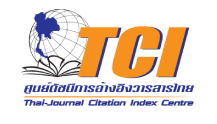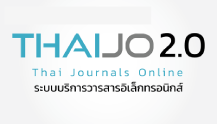Factors Associated with Sarcopenia Amongst Older Adults in Congested Communities in Bangkok
Keywords:
sarcopenia, older adults, congested community, BangkokAbstract
Abstract:
Objective: To describe rate of sarcopenia, and relationship between personal and
health factors with sarcopenia, muscle stungthand walking speed in older adults.
Design: Descriptive research.
Procedure: The participants were 83 older adults from 2 congested communities in
Bangkok. Data were collected by means of structured interviews and a set of instruments
designed to assess nutrition status, body composition, muscle strength, and walking speed.
Data were analysed using descriptive statistics and Chi-square test.
Results: The participants’ average age was 72.2 ± 6.7 years. Rate of sarcopenia was
9.6%. No signifcant relationship was found between sarcopenia and the participants’
overall personal and health factors. However, the participants’ muscle strength was
found signifcantly related to their history of falls (personal factor) and physical activity
(health factor), at χ2 4.375, p .036 and χ2 5.791, p .016, respectively.
Recommendations: Nurses are advised to promote physical activity and monitor
muscle strength in older adults, particularly those with a history of falls.
References
2. Foundation of Gerontology Research and Development Institute (TH). Situation of the Thai elderly 2014. Bangkok: Amarin Printing & Publishing; 2015.
3. Society of Gerontology and Geriatric Medicine (TH). Nutritional management in the elderly. Bangkok: Parbpim; 2014.
4. Thiengtham S, Somboontanont W, Leelahakul V, Hiengkaew V. Physical activity, nutritional status and depression related to sarcopenia in community dwelling older adults. Journal of Nursing Science & Health 2015; 38(4): 1-10.
5. Pongchaiyakul C, Limpawattana P, Kotruchin P, Rajatanavin, R. Prevalence of sarcopenia and associated factors among Thai population. J Bone Miner Metab 2013; 31: 346-50.
6. Cruz-Jentoft AJ, Baeyens JP, Bauer JM, Boirie Y, Cederholm T, Landi F, et al. Sarcopenia: European consensus on definition and diagnosis: Report of the European Working Group on Sarcopenia in Older People. Age Ageing 2010; 39: 412-23.
7. Deutz NE, Bauer JM, Barazzoni R, Biolo G, Boirie Y. Protein intake and exercise for optimal muscle function with aging: recommendations from the ESPEN Expert Group. Clin Nutr 2014; 33(6): 929–36.
8. Chen LK, Liu LK, Woo J, Assantachai P, Auyeung TW, Bahyah KS, et al. Sarcopenia in Asia: consensus report of the Asian working group for sarcopenia. J Am Med Dir Assoc 2014; 15: 95-101.
9. Cherin P, Voronska E, Fraoucene N, Jaeger CD. Prevalence of sarcopenia among healthy Ambulatory subjects: the sarcopenia begins from 45years. Aging Clin Exp Res 2014; 26(2): 46-137.
10. Patel HP, Syddall HE, Jameson K. Prevalence of sarcopenia in community-dwelling older people in the UK using the European Working Group on Sarcopenia in Older People (EWGSOP) definition: findings from the Hertfordshire Cohort Study (HCS). Age Ageing 2013; 42: 84-378.
11. Alexandre TS, Duarte YA, Santos JL, Wong R, Lebrão ML. Prevalence and associated factors of sarcopenia among elderly in Brazil: findings from the SABE study. J Nutr Health Aging 2014; 18(3): 284-90.
12. Steffl M, Bohannon RW, Petr M, Kohlikova E, Holmerova I. Relation between cigarette smoking and sarcopenia: meta-analysis. Physiol Res 2015; 64(3): 26-419.
13. Yuki A, Ando F, Otsuka R, Matsui Y, Harada A, Shimokata H, et al. Epidemiology of sarcopenia in elderly Japanese. J Phys Fitness Sports Med 2015; 4: 111-15.
14. Dorosty A, Arero G, Chamar M, Tavakoli S. Prevalence of Sarcopenia and Its Association with Socioeconomic Status among the Elderly in Tehran. Ethiop J Health Sci 2016; 26(4): 389-96.
15. Han P, Kang L, Guo Q, Wang J, Zhang W, Shen S, et al. Prevalence and factors associated with sarcopenia in suburb-dwelling older Chinese using the Asian Working Group for Sarcopenia definition. J Gerontol A Biol Sci Med Sci 2016; 71: 529-35.
16. Huang CY, Hwang AC, Liu LK, Lee WJ, Chen LY, Peng LN, et al. Association of dynapenia, sarcopenia, and cognitive impairment among community-dwelling older Taiwanese. Rejuvenation Res 2016; 19: 71-78.
17. Tyrovolas S, Koyanagi A, Olaya B, Ayuso-Mateos JL, Miret M, Chatterji S, et al. Factors associated with skeletal muscle mass, sarcopenia, and sarcopenic obesity in older adults: a multi-continent study. J Cachexia Sarcopenia Muscle 2016; 7(3): 312–21.
18. Cholphon A. The characteristics regarding nutritional status of overnutrition students in the schools of Lamphun Municipal Area. Chiangmai: Chiangmai Univ.; 2008.
19. Tanimoto Y, Watanabe M, Sun W, Sugiura Y, Hayashida I, Kusabiraki T, et al. Sarcopenia and falls in community-dwelling elderly subjects in Japan:defining sarcopenia according to criteria of the European Working Group on Sarcopenia in older people. Arch Gerontol Geriatric 2014: 59: 9-295.
20. Kim SH, Kim TH, Hwang HJ. The relationship of physical activity (PA) and walking within Korean males aged 60 years and older using the Fourth Korean National Health and Nutrition Examination Survey (KNHANESIV-2, 3). Arch Gerontol Geriatr 2013; 56(3): 7-472.
21. Chen LK, Lee WJ, Peng LN, Liu LK, Arai H, Akishita M. Recent Advances in Sarcopenia Research in Asia: 2016 Update From the AsianWorking Group for Sarcopenia. JAMD 2016; 17: 767.e1-767.e7.






